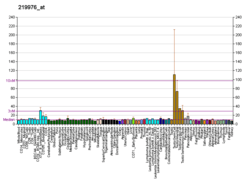HOOK1
Protein Hook homolog 1 is a protein that in humans is encoded by the HOOK1 gene.[5][6]
Function
This gene encodes a member of the hook family of coiled coil proteins, which bind to microtubules and organelles through their N- and C-terminal domains, respectively. The encoded protein localizes to discrete punctuate subcellular structures, and interacts with several members of the Rab GTPase family involved in endocytosis. It is thought to link endocytic membrane trafficking to the microtubule cytoskeleton. Several alternatively spliced transcript variants have been identified, but the full-length nature of some of these variants has not been determined.[6]
gollark: Why would we rectify bees?
gollark: Antidisestablishmentarianism Band Reification.
gollark: Only because ABR isn't here.
gollark: ++delete <@151391317740486657>
gollark: Wrong.
References
- GRCh38: Ensembl release 89: ENSG00000134709 - Ensembl, May 2017
- GRCm38: Ensembl release 89: ENSMUSG00000028572 - Ensembl, May 2017
- "Human PubMed Reference:". National Center for Biotechnology Information, U.S. National Library of Medicine.
- "Mouse PubMed Reference:". National Center for Biotechnology Information, U.S. National Library of Medicine.
- Kramer H, Phistry M (Mar 1999). "Genetic analysis of hook, a gene required for endocytic trafficking in drosophila". Genetics. 151 (2): 675–84. PMC 1460498. PMID 9927460.
- "Entrez Gene: HOOK1 hook homolog 1 (Drosophila)".
Further reading
- Walenta JH, Didier AJ, Liu X, Krämer H (2001). "The Golgi-Associated Hook3 Protein Is a Member of a Novel Family of Microtubule-Binding Proteins". J. Cell Biol. 152 (5): 923–34. doi:10.1083/jcb.152.5.923. PMC 2198811. PMID 11238449.
- Mendoza-Lujambio I, Burfeind P, Dixkens C, et al. (2003). "The Hook1 gene is non-functional in the abnormal spermatozoon head shape (azh) mutant mouse". Hum. Mol. Genet. 11 (14): 1647–58. doi:10.1093/hmg/11.14.1647. PMID 12075009.
- Strausberg RL, Feingold EA, Grouse LH, et al. (2003). "Generation and initial analysis of more than 15,000 full-length human and mouse cDNA sequences". Proc. Natl. Acad. Sci. U.S.A. 99 (26): 16899–903. doi:10.1073/pnas.242603899. PMC 139241. PMID 12477932.
- Ota T, Suzuki Y, Nishikawa T, et al. (2004). "Complete sequencing and characterization of 21,243 full-length human cDNAs". Nat. Genet. 36 (1): 40–5. doi:10.1038/ng1285. PMID 14702039.
- Luiro K, Yliannala K, Ahtiainen L, et al. (2005). "Interconnections of CLN3, Hook1 and Rab proteins link Batten disease to defects in the endocytic pathway". Hum. Mol. Genet. 13 (23): 3017–27. doi:10.1093/hmg/ddh321. PMID 15471887.
- Gerhard DS, Wagner L, Feingold EA, et al. (2004). "The Status, Quality, and Expansion of the NIH Full-Length cDNA Project: The Mammalian Gene Collection (MGC)". Genome Res. 14 (10B): 2121–7. doi:10.1101/gr.2596504. PMC 528928. PMID 15489334.
- Weimer JM, Chattopadhyay S, Custer AW, Pearce DA (2005). "Elevation of Hook1 in a disease model of Batten disease does not affect a novel interaction between Ankyrin G and Hook1". Biochem. Biophys. Res. Commun. 330 (4): 1176–81. doi:10.1016/j.bbrc.2005.03.103. PMID 15823567.
- Simpson F, Martin S, Evans TM, et al. (2005). "A novel hook-related protein family and the characterization of hook-related protein 1". Traffic. 6 (6): 442–58. doi:10.1111/j.1600-0854.2005.00289.x. PMID 15882442.
- Rual JF, Venkatesan K, Hao T, et al. (2005). "Towards a proteome-scale map of the human protein-protein interaction network". Nature. 437 (7062): 1173–8. doi:10.1038/nature04209. PMID 16189514.
- Gregory SG, Barlow KF, McLay KE, et al. (2006). "The DNA sequence and biological annotation of human chromosome 1". Nature. 441 (7091): 315–21. doi:10.1038/nature04727. PMID 16710414.
- Beausoleil SA, Villén J, Gerber SA, et al. (2006). "A probability-based approach for high-throughput protein phosphorylation analysis and site localization". Nat. Biotechnol. 24 (10): 1285–92. doi:10.1038/nbt1240. PMID 16964243.
- Ewing RM, Chu P, Elisma F, et al. (2007). "Large-scale mapping of human protein–protein interactions by mass spectrometry". Mol. Syst. Biol. 3 (1): 89. doi:10.1038/msb4100134. PMC 1847948. PMID 17353931.
This article is issued from Wikipedia. The text is licensed under Creative Commons - Attribution - Sharealike. Additional terms may apply for the media files.




